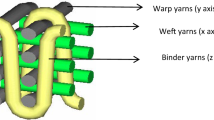Abstract
Internal bond (IB) strength is one of the most important mechanical properties that indicate particleboard quality. The aim of this study was to find a simple regression model that considers the most important parameters that can influence on IB strength. In this study, IB strength was predicted by three kinds of equations (linear, quadratic, and exponential) that were based on the percentage of adhesive (8%, 9.5%, and 11%), particle size (+5, −5 +8, −8 12, and −12 mesh), and density (0.65, 0.7, and 0.75 g/cm3). Our analysis of the results (using SHAZAM 9 software) showed that the exponential function best fitted the experimental data and predicted the IB strength with 18% error. In order decrease the error percentage, the Buckingham Pi theorem was used to build regression models for predicting IB strength based on particle size, density, percentage of adhesive, face-screw withdrawal resistance (SWRf), and edge-screw withdrawal resistance (SWRe). From there, three dimensionless groups were created by Buckingham’s Pi theorem and IB strength was predicted based on multiple regression models. The results showed these models can predict IB strength with 10.68% and 18.17% error, based on face-screw withdrawal resistance and edge-screw withdrawal resistance, respectively.
Similar content being viewed by others
References
Arabi M, Faezipour M, Layeghi M, Enayati AA. 2011. Interaction analysis between slenderness ratio and resin content on mechanical properties of particleboard. Journal of the Indian Academy of Wood Science, 22(3): 461–464.
Arabi M, Faezipour M, Layeghi M, Enayati AA, Zahed R. 2010. Prediction of bending strength and stiffness strength of particleboard based on structural parameters by Buckingham’s p-theorem. Journal of the Indian Academy of Wood Science, 7(1–2): 65–70.
Barnes HM, Lyon MN. 1978. Fastener withdrawal loads for weathered and unweathered particleboard decking. Forest Products Journal, 28(4): 33–36.
Cook DF, Chiu CC. 1997. Predicting the internal bond strength of particleboard, utilizing a radial basis function neural network. Engineering Applications of Artificial Intelligence, 10: 171–177.
Cook DB, Whittaker AD. 1993. Neural-network process modelling of a continuous manufacturing operation. Engineering Applications of Artificial Intelligence, 6: 559–564.
European Standard EN 320. 1993. Fiberboards determination of resistance to axial withdrawal of screws. The European committee for standardization, Brussels, Belgium
European Standard EN 319. 1993. Particleboards and fiberboards: determination of tensile strength perpendicular to the plane of the board. The European committee for standardization, Brussels, Belgium.
Eckelman CA. 1975. Screw holding performance in hardwoods and particleboard. Forest Products Journal, 25: 30–35.
Fernandez FG, Esteban LG, Palacios DE, Navarro PN, Conde M. 2008. Prediction of standard particleboard mechanical properties utilizing an artificial neural network and subsequent comparison with a multivariate regression model. Investigación Agraria: Sistemas y Recursos Forestales, 17: 178–187.
Fujimoto Y, Mori M. 1983. Performance of wood screw joints for particleboard. Science Bulletin of the Faculty of Agriculture. Kyushu University (Japan), 30: 45–47.
Lin HC, Huang JC. 2004. Using single image multi-processing analysis techniques to estimate the internal bond strength of particleboard. Taiwan Journal of Forest Science, 19: 109–117.
Malonay TM. 1977. Modern particleboard and dry process fiberboard manufacturing. San Francisco, CA: Miller Freeman Publication, p. 672.
Post PW. 1958. Effect of particle geometry and resin content on bending strength of oak flake board. Forest Products Journal, 8: 317–322.
Semple KE, Smith GD. 2006. Prediction of internal bond strength in particleboard from withdrawal resistance models. Wood and Fiber Science, 38: 256–267.
Sun YG, Arima T. 1999. Structural mechanics of wood composite materials II: Ultrasonic propagation mechanism and internal bonding of particleboard. Journal of Wood Science, 45: 221–226.
Vignaux GA, Scott JL. 2001. Simplifying regression models using dimensional analysis. Institute of statistics and operations research, Victoria University of Wellington, New Zealand, 12 September.
Zaini IH, Eckelman CA. 1993. Edge and face withdrawal strength of large screws in particleboard and medium density fiberboard. Forest Products Journal, 43: 25–30.
Author information
Authors and Affiliations
Corresponding author
Rights and permissions
About this article
Cite this article
Haftkhani, A.R., Arabi, M. Improve regression-based models for prediction of internal-bond strength of particleboard using Buckingham’s pi-theorem. Journal of Forestry Research 24, 735–740 (2013). https://doi.org/10.1007/s11676-013-0412-3
Received:
Accepted:
Published:
Issue Date:
DOI: https://doi.org/10.1007/s11676-013-0412-3




